
Here, Making Bourbon Isn't a Process. It's a 220-year tradition
At Jim Beam® , we don’t see making bourbon as a process or a job. To us, it’s an art form—a collaboration between our master distiller and Mother Nature where every ingredient, every shift in the weather and every oak stave come together to make Jim Beam® the World’s #1 Bourbon. So, if you’re curious about the craft, here’s a crash course on how it’s done.

STEP 1: START WITH OUR SECRET RECIPE
We start with a mix of corn (at least 51%), rye and malted barley. This is what’s known as our “mash bill.” It feeds into a 10,000-gallon cooker where we add some “setback” (a portion of the old mash from our last distillation). This helps to ensure consistency and transform our mash into “sour mash.”
STEP 2: ADD KENTUCKY WATER
It’s no coincidence that more than 95% of all bourbon comes from Kentucky. The real secret is the water. You see, any whiskey made from water containing iron will turn black and have a slightly metallic taste—not exactly appealing. Kentucky, however, just so happens to sit on a natural limestone shelf that acts as a filter, creating iron-free, calcium-rich water. This helps to craft the slightly sweet, golden brown bourbon we all know and love.


STEP 3: BRING ON THE YEAST
Once we’ve cooked our sour mash, we transfer it from the cooker to the fermenter, cool it to 60–70°F and add yeast to eat the sugars and create alcohol. But this isn’t just any old yeast. It’s a very specific old yeast—the same strain we’ve been using since the end of Prohibition in 1933. So that bottle of Beam in the picture from your granddad’s 1950s fishing trip, you’d better believe it came from that same yeast. Talk about consistency… And, yes, it’s another closely guarded family secret—so guarded, in fact, that Jim Beam® himself would take a jug of yeast home every weekend for safe keeping. And today, more than 85 years later, Jim Beam® ’s great-grandson still upholds that same tradition.
STEP 4: DISTILL TWICE FOR ONE SMOOTH FLAVOUR.
After the fermentation process, we’re left with what’s known as “distiller’s beer,” which coincidentally happens to look, smell and taste like a rich beer. This distiller’s beer is transferred into a 65-foot-tall column still where we heat it to around 200°F—enough to turn the alcohol into a vapor, separating it from the other ingredients. That vapor then turns back into a 125-proof liquid known as “low wine” and flows into a doubler (similar to a pot still) for a second distillation. The next time the vapor condenses, it will be a less-than-160-proof “high wine.”


STEP 5: AGE IN NEW, LEVEL-4 CHAR OAK BARRELS.
The wood whiskey ages in has a lot to do with its final flavor. And not just the type of wood—whether it’s charred, seared or toasted and to what level. At Jim Beam® , we tap our high wine into brand-new, level-4 char, American White Oak barrels. We call this level of char “alligator char” because, after being fired, the inside of the barrels take on the scaly, bumpy look of a gator’s skin. This also caramelizes the sugars within the wood to create a richer flavor with fewer tannins.
STEP 6: AGE TWICE AS LONG AS THE LAW REQUIRES.
After filling our barrels (each one holds about 53 gallons of bourbon), we roll them into one of our airy, hilltop rackhouses to rest. As the seasons change, Kentucky’s climate expands and contracts the barrel wood, allowing bourbon to seep into the barrel and extract the caramelized sugars, oak flavor and beautiful, golden-brown color from the charred wood. Throughout this “breathing” process, a fair portion of the 53 gallons of bourbon escapes the barrel through evaporation. This is known as the “angel's share,” and the longer a bourbon ages, the more the angels take. According to bourbon law, two years gets you Straight Bourbon Whiskey. But only four years gets you the smooth, mellow flavor of Jim Beam®


Timeline of Family Heritage
The story of the Beam family is one of seven generations, more than 200 years, countless challenges and one goal; to make the best bourbon in the world. So settle in, pour yourself a bourbon and prepare to travel back in time with the First Family of Bourbon.










